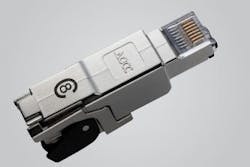TIA-1152-A Category 8 testing standard approved
At its October meeting, the TIA’s TR-42.7 subcommittee resolved all comments on the ANSI/TIA-1152-A standard and authorized publication of the document. TIA-1152-A covers Category 8 testing in the field. In development since late 2013, the standard specifies Level 2G testing accuracy. Category 8 cabling systems are specified to a frequency up to 2 GHz (2000 MHz).
With the TIA’s approval of Category 8 cabling specifications earlier this year, and this more recent approval (and imminent publication) of TIA-1152-A, all elements are in place for the development, availability and deployment of Category 8 components and systems.
Two producers of twisted-pair cabling test equipment—Softing and Fluke Networks—recently commented on the Category 8 testing specifications. Softing’s business development manager Mike Bunning recently wrote about the company’s WireXpert tester, “The engineers who first designed WireXpert eight years ago knew 40G was coming and deliberately overbuilt a 10G unit with a frequency range to 1,600 MHz. In the process, someone realized that changing out one small component could boost this range to 2,500 MHz. It was a dizzying amount of bandwidth headroom at the time. But the cost was low, so they built it into their next release … There is certainly more to certifying Category 8 cable systems than additional bandwidth. But at the moment, WireXpert is the only tester out there with the necessary frequency range.”
Mark Mullins, marketing manager with Fluke Networks, wrote, “If you’re not familiar with deploying and testing shielded cable, you will have to be with Category 8. That means installers and contractors will need to ensure prudent cable-connector shield termination and proper grounding and bonding measures. In a data center where a copper link is running from one grounded panel in a grounded rack to another grounded panel in a grounded rack, an open shield can still pass wire map. That is because shield continuity is historically a DC measurement that will reach the remote unit through the common building ground rather than through the cabling link. As a result, troubleshooting a link with an open shield will be extremely difficult. Thankfully Fluke Networks already has the technology to address the issue. Only the DSX-5000 CableAnalyzer offers shield integrity testing using a patented AC measurement technique for preventing grounded racks in a data center showing that the shield is connected, even when it isn’t.”
Mullins added, “You’ve got plenty of time to get a handle on all the ins and outs of Category 8. There are no Category 8 components currently shipping, nor is there any 25GBase-T/40GBase-T equipment commercially available.”
